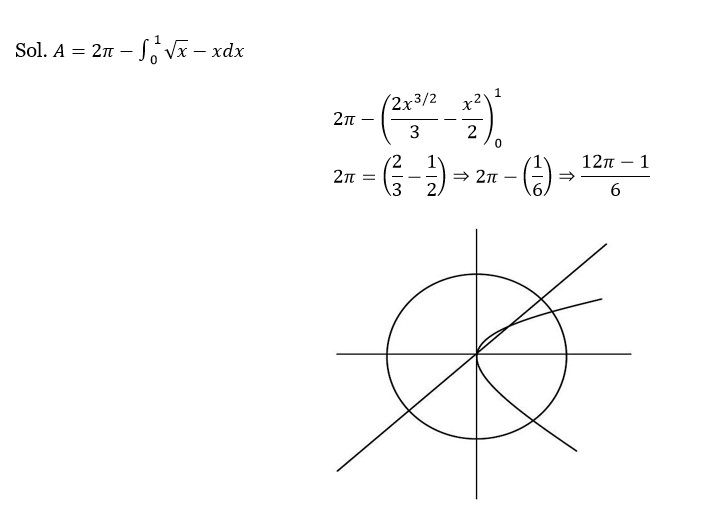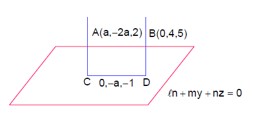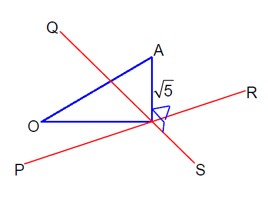Class 12th
Get insights from 12k questions on Class 12th, answered by students, alumni, and experts. You may also ask and answer any question you like about Class 12th
Follow Ask QuestionQuestions
Discussions
Active Users
Followers
New answer posted
2 months agoContributor-Level 10
The angle bisector a is parallel to λ ( b? +? ) or μ ( b? -? ).
b? = (i+j)/√2 and? = (i-j+4k)/√ (1+1+16) = (i-j+4k)/ (3√2).
Case 1: a = λ ( (i+j)/√2 + (i-j+4k)/ (3√2) )
a = λ/√2 * (3 (i+j) + (i-j+4k)/3 = λ/ (3√2) * (4i + 2j + 4k).
a is given as αi + 2j + βk.
Comparing the j-component: 2 = λ/ (3√2) * 2 ⇒ λ = 3√2.
So, a = 1 * (4i + 2j + 4k) = 4i + 2j + 4k.
Comparing with αi + 2j + βk, we get α = 4 and β = 4.
(The image has a second case that needs evaluation as well).
Case 2: a = μ ( b? -? )
a = μ/ (3√2) * (3 (i+j) - (i-j+4k) = μ/ (3√2) * (2i + 4j - 4k).
Comparing the j-component: 2 = μ/ (3√2) * 4 ⇒ 4μ
New answer posted
2 months agoContributor-Level 10
Area A = 2π - ∫? ¹ (√x - x) dx is incorrect. The area is likely between two curves.
The calculation shown is:
A = 2π - [2/3 x^ (3/2) - x²/2] from 0 to 1.
A = 2π - (2/3 - 1/2) = 2π - (4/6 - 3/6) = 2π - 1/6 = (12π - 1)/6.
New answer posted
2 months agoContributor-Level 10
Given kx^ (k-1) + k * y^ (k-1) * dy/dx = 0.
dy/dx = - (kx^ (k-1) / (ky^ (k-1) = - (x/y)^ (k-1).
The provided solution has dy/dx + (x/y)^ (k-1) = 0.
It seems to relate to k-1 = -1/3, which implies k = 1 - 1/3 = 2/3.
New answer posted
2 months agoContributor-Level 10
A = 1/3 [ 1; 1 ω ω² 1 ω² ω ]
A² = A * A = 1/9 [ . ]
(The calculation in the image shows A² is the identity matrix, let's verify)
A² leads to I (Identity matrix).
So A² = I.
A³ = A² * A = I * A = A.
A? = (A²)² = I² = I.
A³? = (A²)¹? = I¹? = I.
New answer posted
2 months agoContributor-Level 9
dy/dx + 2y tan (x) = sin (x)
I.F. = e^ (∫2tan (x)dx) = e^ (2ln (sec (x) = sec² (x)
Solution is y sec² (x) = ∫sin (x)sec² (x)dx = ∫sec (x)tan (x)dx
⇒ y sec² (x) = sec (x) + c
y (π/3) = 0 ⇒ 0 * sec² (π/3) = sec (π/3) + c ⇒ 0 = 2 + c ⇒ c = -2.
∴ y = (sec (x) - 2) / sec² (x)
Now let g (t) = (t - 2)/t² = 1/t - 2/t² for |t| ≥ 1.
g' (t) = -1/t² + 4/t³
g' (t) = 0 ⇒ t = 4.
g' (t) = 2/t³ - 12/t? g' (4) < 0, hence maximum.
∴ g (t)max = g (4) = (4 - 2)/4² = 2/16 = 1/8.
New answer posted
2 months agoContributor-Level 10
The equation of the line is (x-2)/1 = (y-1)/1 = (z-6)/-2.
Let this be equal to k. So, a point on the line is (k+2, k+1, -2k+6).
This point lies on the plane x + y - 2z = 3.
(k+2) + (k+1) - 2 (-2k+6) = 3
2k + 3 + 4k - 12 = 3
6k - 9 = 3
6k = 12 ⇒ k = 2.
The point of intersection is (2+2, 2+1, -2 (2)+6) = (4, 3, 2).
New answer posted
2 months agoContributor-Level 9
PR (line): r = (3i - j + 2k) + λ (4i - j + 2k) - (I)
QS (line): r = (i + 2j - 4k) + μ (-2i + j - 2k) - (II)
If they intersect at T then:
3 + 4λ = 1 - 2μ
-1 - λ = 2 + μ
2 + 2λ = -4 - 2μ
Solving the first two equations gives λ = 2 & μ = -5. These values satisfy the third equation.
∴ T (11, -3, 6)
Also, OT is coplanar with lines PR and QS.
⇒ TA ⊥ OT
|OT| = √166
|TA| = √5
|OA| = √ (|OT|² + |TA|²) = √171
Taking an Exam? Selecting a College?
Get authentic answers from experts, students and alumni that you won't find anywhere else
Sign Up on ShikshaOn Shiksha, get access to
- 65k Colleges
- 1.2k Exams
- 679k Reviews
- 1800k Answers




